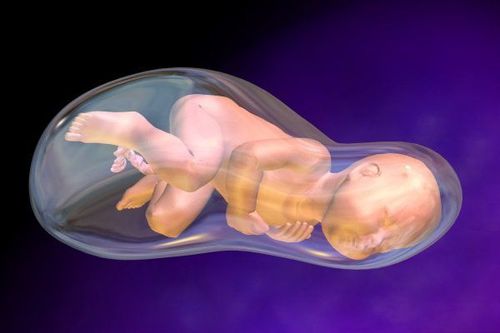This is an automatically translated article.
The article was professionally consulted by Specialist Doctor I Le Hong Lien - Department of Obstetrics and Gynecology - Vinmec Central Park International General HospitalAmniotic fluid usually appears around the 12th day after conception. This is the nutrient environment that protects the fetus, liquid water is contained in the amniotic cavity of the pregnant woman. Lack of amniotic fluid can seriously affect the fetus leading to complications for both mother and baby.
1. What is lack of amniotic fluid?
Amniotic fluid deficiency is a condition in which amniotic fluid is less than normal, when the amniotic fluid index (AFI) is less than 5 cm and the amniotic membrane is intact. In general, amniotic fluid deficiency occurring early in pregnancy is uncommon and has a poor prognosis. In contrast, lack of amniotic fluid often occurs in pregnancies past the due date, intrauterine growth retardation. Definitive diagnosis is mainly based on fetal ultrasound and amniotic fluid.2. When is a pregnant woman diagnosed with a lack of amniotic fluid?
Amniotic fluid index (AFI) is used to assess amniotic fluid status. To measure this index, the doctor will perform the following procedure: Take the navel as a landmark, divide the abdomen into 4 parts with 2 vertical and horizontal lines, in each part, the doctor chooses the deepest amniotic sac to measure the length. Adding these 4 lengths will give the AFI amniotic index.Based on the detailed table below, pregnant women can know whether their amniotic fluid index is normal or abnormal including: lack of amniotic fluid or amniotic fluid.

| Mức độ | AFI (cm) | Lưu ý |
| Bình thường | 6 - 18cm | Thai phụ có thể yên tâm với chỉ số này. |
| Dư ối | 12 - 25 | Thai phụ có thể yên tâm vì dư ối nằm trong chỉ số này là bình thường. |
| Đa ối (bệnh lý) | > 25cm | Đa ối có thể gây ra nhiều biến chứng cho thai nhi như: mẹ bị vỡ ối sớm, sinh non, ngôi thai bị đảo lộn bất thường có thể dẫn đến sinh mổ, túi ối bị căng quá sẽ làm cho nhau bong non. Ngoài ra, nước ối nhiều cũng sẽ gây nên tình trạng đờ tử cung, sản phụ có nguy cơ bị băng huyết sau khi sinh. |
| Thiểu ối | <= 5cm | Thiểu ối có thể gây ảnh hưởng đến cả thai nhi lẫn thai phụ cụ thể: tăng tỷ lệ sinh mổ, tăng tỷ lệ suy thai và dị tật thai nhi. |
| Vô ối | <3cm | Thiếu ối trầm trọng sẽ dẫn đến vô ối và có thể dẫn đến thai chết lưu hoặc sinh non. |
3. Dangerous complications of lack of amniotic fluid
3.1 Early stage lack of amniotic fluid
The occurrence of oligohydramnios in early pregnancy is likely to increase the risk of pulmonary hypoplasia, for the fetus. According to one study, which observed 115 women whose membranes broke before 29 weeks, there were 7 stillbirths, 40 neonatal deaths, and an estimated perinatal mortality rate of 409/1000. The risk of pulmonary hypoplasia causing fetal death is about 20%.>>> Premature rupture of membranes occurs in which case?
Premature oligohydramnios is often associated with abnormal fetal effects. Low amniotic fluid status will also interfere in the ultrasound examination of the fetus's morphology (if any). In this case, the indication for amniocentesis may also be considered.
3.2 Late stage amniotic fluid deficiency
Complications of oligohydramnios appearing late in pregnancy depend on the gestational age, the degree of oligohydramnios and the mother's comorbid conditions. Doctors often help patients improve this condition by instructing the mother to drink lots of water or give fluids.
3.3 Low amniotic fluid in the last 3 months
Pregnant women with lack of amniotic fluid in the last 3 months can cause the fetus to be malnourished and dangerous to the baby's life. If the fetus is 37 weeks old, the doctor will assign birth, if it is more than 34 weeks, the doctor may prescribe intervention measures (rest, drink plenty of fluids, fluids, close monitoring...) for the fetus to reach 37 weeks.During that time, a pregnant woman can be ordered by a doctor to give birth at any time if there is a risk of complications. In addition, oligohydramnios in the last 3 months of pregnancy also has the potential to make the fetus malnourished.
Therefore, during this last 3 months, pregnant women need to regularly go for ultrasound and check the pregnancy to be able to detect these phenomena in time (if any) and treat them promptly.
At the Department of Obstetrics and Gynecology - Vinmec International General Hospital has solved many difficult cases such as: premature rupture of membranes, polyhydramnios, placenta accreta, knotted umbilical cord, preterm pregnancy... More convenient, Vinmec has implemented PACKAGE Maternity Packages, including prenatal care, during childbirth and after birth. Pregnant women are monitored and carried out all necessary tests and ultrasounds to detect pregnancy abnormalities early. The birth will be "gentle" like going on vacation, at the hospital, there are fully equipped for mother and baby.
Vinmec International General Hospital gathers a team of highly qualified doctors at home and abroad as well as the quality of ultrasound machine system, modern equipped medical equipment, main prenatal examination procedures. Accurately, science will handle abnormalities during pregnancy and labor quickly, helping women have the safest pregnancy.
Please dial HOTLINE for more information or register for an appointment HERE. Download MyVinmec app to make appointments faster and to manage your bookings easily.














